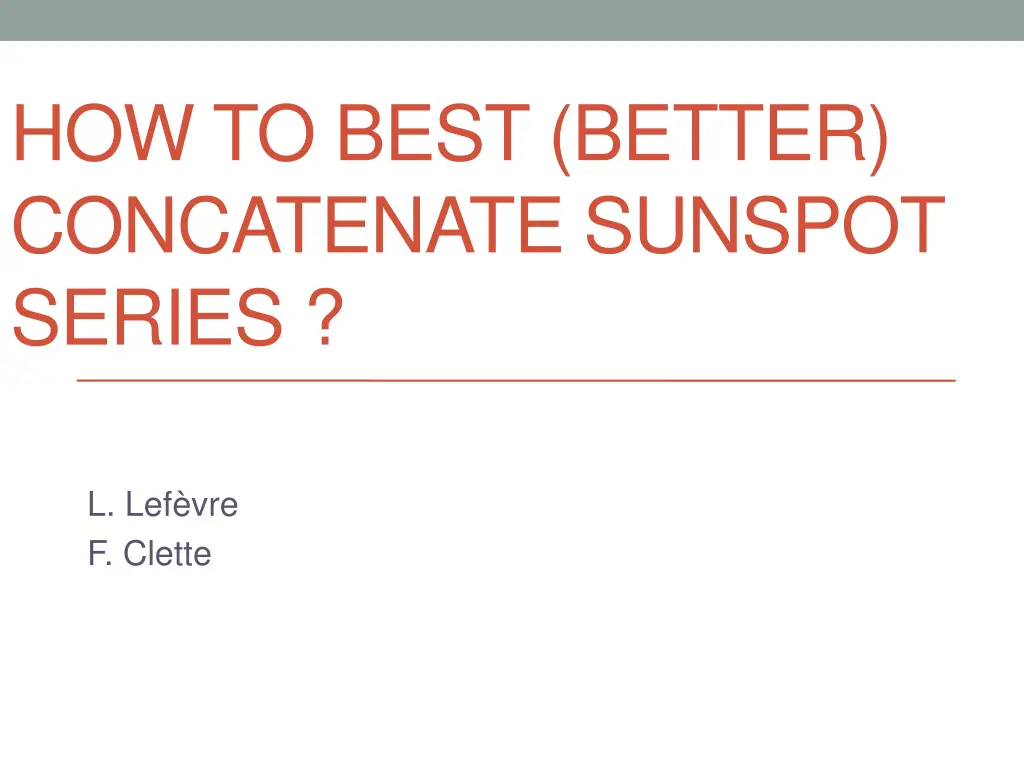
Concatenate Sunspot Series: A Detailed Analysis
Explore the ADF method for concatenating sunspot series, understanding its pros and cons, observational coverage, and sensitivity to calibration intervals. Discover how it determines relations between observers at sunspot maxima. Dive into examples and insights provided by Lefèvre, Clette, Wolf, Schmidt, Schwabe, Wolfer, and more.
Download Presentation

Please find below an Image/Link to download the presentation.
The content on the website is provided AS IS for your information and personal use only. It may not be sold, licensed, or shared on other websites without obtaining consent from the author. If you encounter any issues during the download, it is possible that the publisher has removed the file from their server.
You are allowed to download the files provided on this website for personal or commercial use, subject to the condition that they are used lawfully. All files are the property of their respective owners.
The content on the website is provided AS IS for your information and personal use only. It may not be sold, licensed, or shared on other websites without obtaining consent from the author.
E N D
Presentation Transcript
HOW TO BEST (BETTER) CONCATENATE SUNSPOT SERIES ? L. Lef vre F. Clette
THE ADF METHOD Active Day Fraction
ADF method: pros and cons Not dependent on actual time overlap. Takes observational parameters into account (limit of size an observer can see). Does take into account the quality of the input data of observers in a general statistical way (no months nobs<3) However, there is a bias not in the number of observations but in the window : tendency to observe mainly when the Sun is active. (EXAMPLE Wolf, and others) Does not take into account group splitting effect (should be quantified at least to justify such a lack). Method fits observers ADF between 0.1 and 0.8 (Misses ALL the high regime sunspot data between 0.8 and 1 see figures later). Sensitivity to calibration interval
ADF method Observational coverage : serious bias towards active days If you look at the distribution of ADF versus number of groups or Sunspot Number, you can easily see that more than 50% of the distribution is between 0.8 and 1 and that ALL the maxima of the Sunspot Number are above 0.9 Problems with the range of the reference dataset: obs except Quimby and Wolfer are calibrated with 1900-1976, but if you try and calibrate Wolfer and Quimby with the same it does not work. The whole CDF range (y axis) varies.
ADF versus activity regime (SN) How can we determine relations between observers at maxima ? Wolfer Winkler
ADF versus activity regime (GN) How can we determine relations between observers at maxima ? Wolfer Winkler
Importance of the calibration period Wolfer is supposed to have a threshold of 6(0-12). Calibration period : 1900-1976 Calibration period : 1900-1928
Importance of the calibration period Quimby is supposed to have a threshold of 22(16-28). Calibration period : 1900-1976 Calibration period : 1900-1921
Importance of the Calibration period 1900-1976: 45(36-53)
ADF versus activity regime (GN) Relations at maxima not well defined Wolfer
SS Versus ADF Comparison of ADF versus Svalgaard backbone method. Differences between maxima.
As already mentioned several times, using yearly averages to compare datasets is not the best idea. It is probably best to work on daily data and only compute monthly and yearly averages ONCE the studies have been made on daily data. However, data are never perfect, and techniques must adapt to the quality of the observations.
Is a mixed method possible ? Adaptative k factor, depending on the regime of activity and also, we need to take care of the evolution of the relation (whatever it is) with time.
